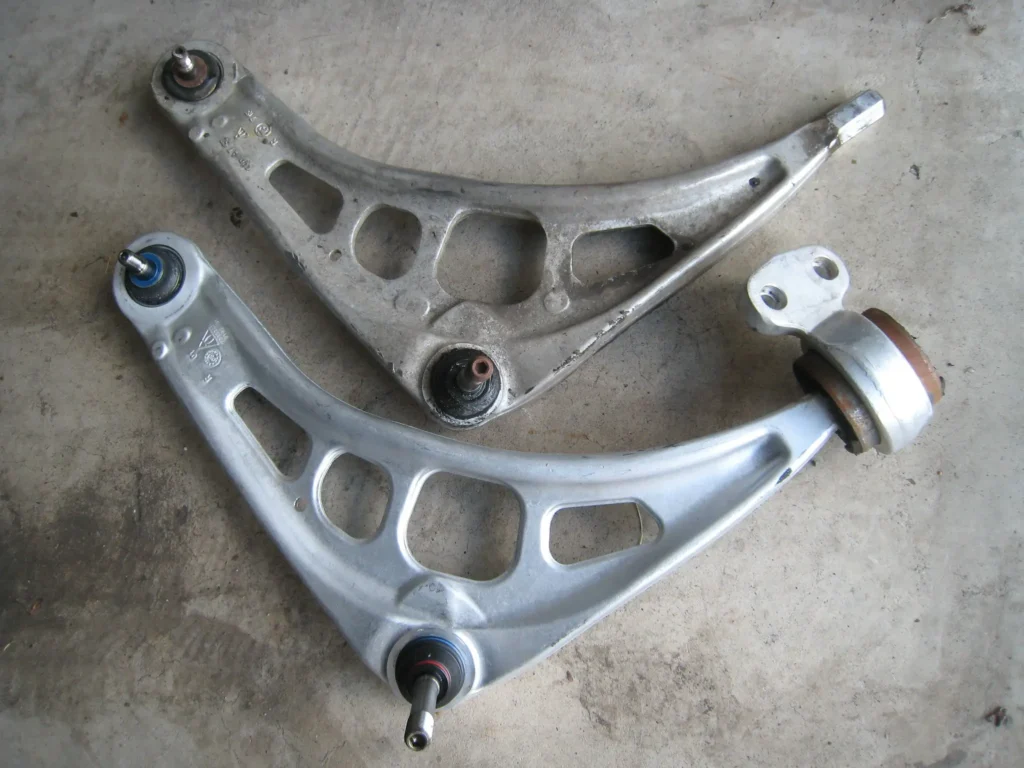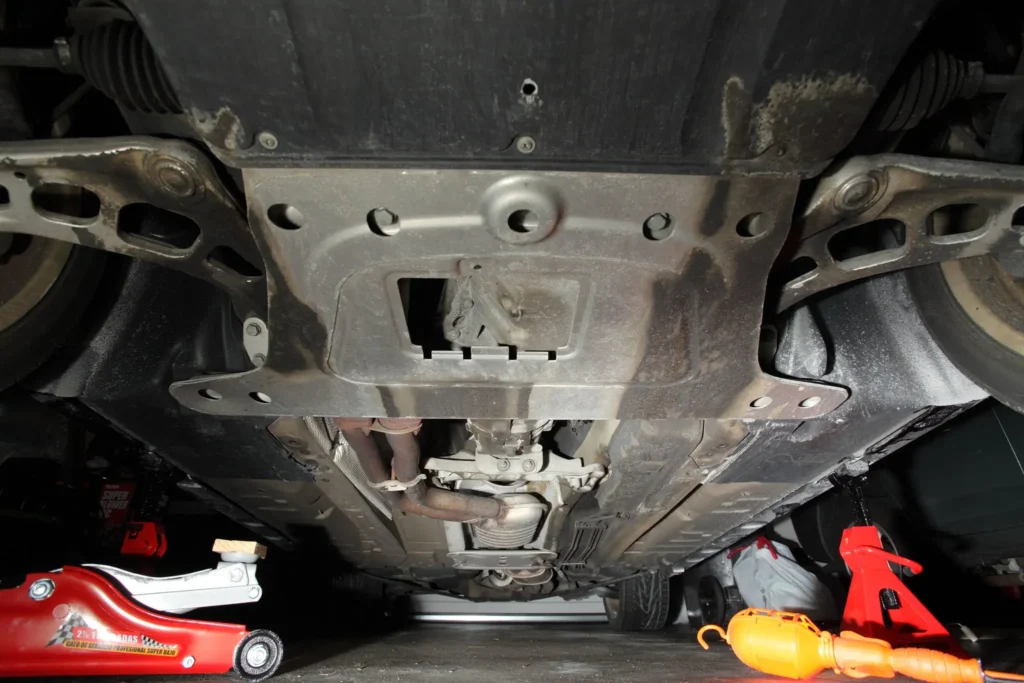The lower control arm is a critical suspension component that connects the wheel hub to the vehicle’s chassis. It allows the wheels to travel vertically over bumps while maintaining proper geometry for stability and control. Over time, the lower control arm bushings, ball joints, and other components can wear out, causing steering, vibration, and safety issues.
Recognizing the Symptoms of Bad Lower Control Arm is important to get it replaced before catastrophic failure. This comprehensive guide covers common bad lower control arm symptoms, what causes them to fail, prevention tips, and replacement costs.
What Does the Lower Control Arm Do?
Before jumping into symptoms, let’s review the role of the lower control arm in a vehicle’s suspension:
- Connects the wheel hub and knuckle to the frame with bushings and ball joints
- allows the wheel to move vertically up and down while driving
- Maintains proper suspension geometry for wheel alignment
- Absorbs road impacts and vibrations for a smooth ride
- Supports vehicle weight with the strut or shock absorber
- Pivots when turning for steering capability

The lower control arm handles a lot of stress from suspension movement, payload weight, impacts, and steering forces. It’s no surprise these components wear out over time.
4 Common Symptoms of Bad Lower Control Arm
Here are four of the most common signs of worn control arm bushings, ball joints, and related components:
1. Clunking Noises Over Bumps
As the rubber bushings harden and crack or ball joints loosen, you’ll hear clunking, knocking, or banging noises from the front suspension. It usually occurs when going over bumps, turning, braking, or accelerating.
The noises indicate play has developed in the once-tight joints. You’ll feel a loss of control too as the suspension geometry shifts under loads.
2. Vehicle Pulling in One Direction
Symptoms of Bad Lower Control Arm. Does your vehicle pull to the right or left without any steering wheel input? If your wheel alignment is good, worn lower control arm components could be the culprit.
As the bushings stretch or ball joints wear, it allows more unwanted rotation and wobbling of the wheel hub. This puts your suspension geometry out of spec, making the vehicle pull to one side.
3. Uneven Tire Wear
Take a look at your tires’ tread depth and wear patterns. Are the inner or outer tread edges wearing faster than the rest of the tire? This symptom relates to the alignment and wheel wobbling we just covered.
Bad lower control arms throw off your alignment by allowing too much-unwanted wheel movement. This forces tires to drag and slip, creating uneven tread wear. Rotate tires regularly to inspect wear patterns.
4. Excessive Steering Wheel Vibration
Does your steering wheel shake excessively over 40 mph when hitting no bumps? If so, take a look under the vehicle for a compromised lower control arm.
Symptoms of Bad Lower Control Arm. the The looseness allows the wheels to wobble rapidly back and forth. These violent oscillations transfer through the suspension and steering, feeling like strong vibrations in the cabin. Bad wheel bearings can cause this too.
What Causes Lower Control Arms to Fail?
Lower control arms face a lot of stressors daily. Here are some of the most common Symptoms of Bad Lower Control Arm:
Age and Mileage: The rubber and plastic components naturally harden and crack over time and miles. Ball joints also wear out internally.
Severe Service: Off-roading, repeated hard impacts, heavy payloads, aggressive driving, snow plowing, and towing all accelerate wear.
Design Flaws: Some vehicles are prone to premature control arm bushing or ball joint failures, requiring updated replacement parts.
Accidents and Impacts: Hitting curbs, rocks, debris, or anything solid can dent, bend, or tear the control arms. The damage may be hidden at first.
Environmental Exposure: Road salt, mud, water, and temperature extremes degrade rubber and seals faster.
With so many stressors, make sure to inspect control arms periodically. Catching wear early allows for less costly repairs before secondary damage or failure.
Consequences of Driving on a Bad Control Arm
Symptoms of Bad Lower Control Arm. It’s tempting to put off the replacement of a compromised lower control arm. But driving on one with excessive play is extremely dangerous. Here’s what can happen:
Complete Failure: Hit one more bump or turn and a severely worn ball joint or bushing can separate. This leads to a loss of steering control or the wheel collapsing under the vehicle. Both outcomes often result in a crash.
Secondary Damage: If separation doesn’t occur suddenly, the wobbling wheels and suspension put damaging forces into other components like wheel bearings, CV axles, tires, and more. This amplifies repair costs.
Alignment Shifts: A loose lower control arm radically alters suspension geometry. As it moves, your alignment specifications shift, leading to unpredictable vehicle control and crashes.
Safety Hazards: Between the loss of control, debris damaging undercarriages of other vehicles if components break off, and wheels folding under, driving with compromised control arms poses huge risks to driver and passenger safety.
It’s critical to the safety of your passengers, other motorists, and the long-term health of your vehicle to replace worn control arm components immediately. Tow it or have it transported on a flatbed if driveshaft damage is also suspected.
How Much Does It Cost to Replace Lower Control Arms?
Replacement costs vary substantially based on:
- Make and model of vehicle
- If you replace just the bushings and ball joints, or the entire control arm assembly
- Whether you replace just one side or both
- If other steering and suspension components need repair at the same time
With those qualifiers, here are some ballpark figures:
Component Replacement: $150-300 per control arm to replace just the bushings and ball joints. Requires a shop press for removal/installation. Total: $300-600 for both left and right arms.
Control Arm Assembly: $220-500 for pre-assembled replacement arms with bushings and ball joints installed. Bolts right on without a press. Total both sides: $440-1,000+
Additional Repairs: If worn tie rods, stabilizer bar links, struts, or other components are uncovered during control arm replacement, costs go up $200-1000+
Labor Charges: Expect 1-3 hours per side at $100-150 hourly. Adds $200-900 for installation.
Dealerships are the most expensive, followed by chain shops. Independent mechanics usually offer the lowest rates. Replacing both control arms at a dealership can easily top $1,500 with parts and labor.

Tips to Make Control Arms Last
Here are six proven tips to maximize the lifespan of your vehicle’s lower control arms:
1. Inspect often: Check bushings, ball joints, and boots every 6 months and whenever you rotate tires or change oil. Look for rips, cracks, and grease leakage.
2. Replace dust boots: Split or missing seals let contaminants damage joints. Replace torn ones immediately. Upgrade to durable polyurethane boots for longer life.
3. Lubricate periodically: If ball joints have grease fittings, pump in fresh lubricant every 1-2 years. This flushes out old contaminated grease, extending joint life significantly.
4. Install upgraded arms: Consider replacing worn factory arms with heavy-duty aftermarket arms. Their components often outlive OEM parts, some offering “lifetime” warranties.
5. Improve driving habits: Avoid curbs and potholes, lighten loads when possible, ease up on heavy acceleration and braking, and go slower off-road to reduce suspension stress.
6. Wash regularly: Hose off mud and road salt from undercarriages to minimize corrosion of mounts, bushings, and ball joints.
While you can’t stop lower control arms from eventually wearing out, following these tips religiously can add years of extra service. Plus, take action at the first sign of symptoms for substantial cost savings over allowing catastrophic failure.
FAQ – Symptoms of Bad Lower Control Arm
Here are answers to common questions about the symptoms, causes, and fixes for worn lower control arms:
How do I know if my lower control arm is bad?
Listen and watch for clunking noises, steering pulling, uneven tire wear, or vibration. Confirm with visual inspection. Look for cracked rubber, gaps in bushings, bent arms, and torn boots. Grab the wheel and shake it back and forth and up and down to check for excessive play indicating worn ball joints.
How do I know when to replace my lower control arm?
As soon as you notice symptoms, thoroughly inspect the components. If rubber bushings reveal any cracks or large splits, ball joints have more than 0.1 inches/2.5mm of vertical play, or anything shows signs of severe corrosion, replacement is needed. Damage won’t improve with time or miles.
What happens if you drive with a bad lower control arm?
Driving with play exceeding manufacturers’ specifications from damaged lower control arm components can lead to sudden catastrophic failure, loss of control, accidents, secondary component damage costing extra for repairs, and irregular tire wear from ongoing alignment changes. Replace immediately.
What does a bad control arm feel like?
You’ll feel a loss of stable handling as the vehicle wanders without precision. Hitting bumps and dips causes more crashing jolts through the chassis without being adequately absorbed by bushings. Turning feels loose rather than crisp. You’ll likely sense something just isn’t right as you drive.
What problems can a bad control arm cause?
Common problems from driving on a bad control arm include loss of control, accidents, coil spring collapse if the ball joint fails, fire from components dragging on the road, damage to other steering and suspension parts from excessive wheel wobble, and costly premature tire replacement from ruining the tread.
The Bottom Line – Symptoms of Bad Lower Control Arm
Lower control arms contain some of the most safety-critical steering and suspension components. Inspect ball joints, bushings, and boots regularly. Know the common symptoms of wear like clunking, pulling, vibration, and tire wear patterns. Symptoms of Bad Lower Control Arm. Catching problems early leads to affordable repairs and averts dangerous failures.
Prioritize replacement at the very first sign of deterioration. Tow it if you suspect adjacent component damage. And consider upgrading to heavy-duty control arms to extend service intervals. Investing in these preventive steps pays dividends for safe, smooth, and controlled driving performance.

